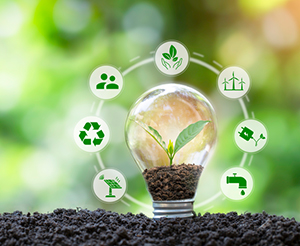Megatrends and Sustainable Development
11 June 2024
What are megatrends! Good question that we’ll take a look at in this blog post in addition to how they relate to environmental management and sustainability.
 FIRST MENTION OF MEGATRENDS
FIRST MENTION OF MEGATRENDSThe term megatrend was first coined in the early 1980s by futurologist John Naisbitt in his book “Megatrends: Ten New Directions Transforming Our Lives’. As our IEMA students should know they are trends in society that have an impact on a global scale. Having an understanding of them is key to getting to grips with sustainability impacts.
‘ROOT CAUSES’ OF SUSTAINABILITY ISSUES?
I’m the sort of person who wants to know how and why something got here whether it is a building, animal, technology or people! I find the journey just as interesting as the destination. I often think of megatrends as being the ‘root causes’ of sustainability issues. They are what leads to most or arguably all sustainability impacts. They tend to be categorised as social, economic, political, environmental or technological changes. I’ve seen many different lists of megatrends over the years and as far as I am aware there is no definitive list.
ELEVEN MEGATRENDS
Perhaps a good approach to breaking them down is taken by the European Environment Agency who define eleven megatrends. It is a holistic list covering a whole host of different issues, which are:
Diverging global populations trends
Towards a more urban world
Changing disease burdens and risk of pandemics
Accelerating technological change
Continued economic growth?
A increasing multipolar world
Intensified global competition for resources
Growing pressure on ecosystem
Increasing severe consequences of climate change
Increasing environmental pollution, and diversifying approaches to government.
BIG ISSUES
Another approach taken by the global consulting firm PWC is to categorise megatrends as climate change, technological disruption, demographic shifts fracturing the world and social instability. No matter how megatrends are categorised as we can see these are certainly big issues that I spend a lot of time discussing as a course tutor.
Each megatrend is a massive issue. However, they also impact each other for example changes in particular have many links to the other megatrends. For example, risk of pandemics and disease burdens are increased, accelerating technological change could lead to more greenhouse gas emissions, or conversely less if we can create climate friendly technological solutions. There are likely to be changes in migration as places around the world become more inhospitable. This is just one megatrend the others in most cases are just as positively or negatively linked.
UNDERSTANDING THE TRIPLE BOTTOM LINE ISSUES
When dealing with megatrends we need to understand the triple bottom line (social, environment and economic) issues. There is no use in just considering one of these issues. Take for example climate change energy is needed for heating in many parts of the world (social need) it needs to have a limited environmental impact (low amount of greenhouse gas and other emissions) and it needs to be affordable (economic). Just as it is for sustainability there will need to be some trade-offs required to solve these problems, balancing ‘People, Planet and Profit’ is key.
These are just a few of my musings on megatrends. It is well worth you exploring this topic further.
They are key subjects which every environmental practitioner should be aware of. They are what lead to many of the organisational risks that we must deal with on a day to day basis. Understanding these social, economic, political, environmental or technological changes is certainly core knowledge for those who want to progress in the field and really make a difference.
Other Press Releases By This Company
- 16/12/2024 - Living Planet Index Report Release 2024
- 13/11/2024 - Planetary Boundaries: A Planetary Health Check
- 13/11/2024 - Health and Safety: Looking to the Future
- 11/10/2024 - An Introduction to Science Based Targets
- 19/09/2024 - Environmental Management – Training, Awareness, and Competence
- 31/07/2024 - Environmental Commitments of the New UK Government
- 17/07/2024 - Building a Business Case for Environmental Improvements
- 16/05/2024 - RRC Environmental tutor John Binns looks deeper at monitoring that is required to determine environmental performance.
- 16/04/2024 - Guidance on Developing an Environmental Compliance Obligations Register
- 16/04/2024 - Managing Psychological Stress in the Workplace
- 04/04/2024 - IEMA and CWP Launch New Digital Series ‘Transforming the World to Sustainability’
- 04/04/2024 - "Top Tips for the NEBOSH Environmental Management Certificate Open Book Exam".




